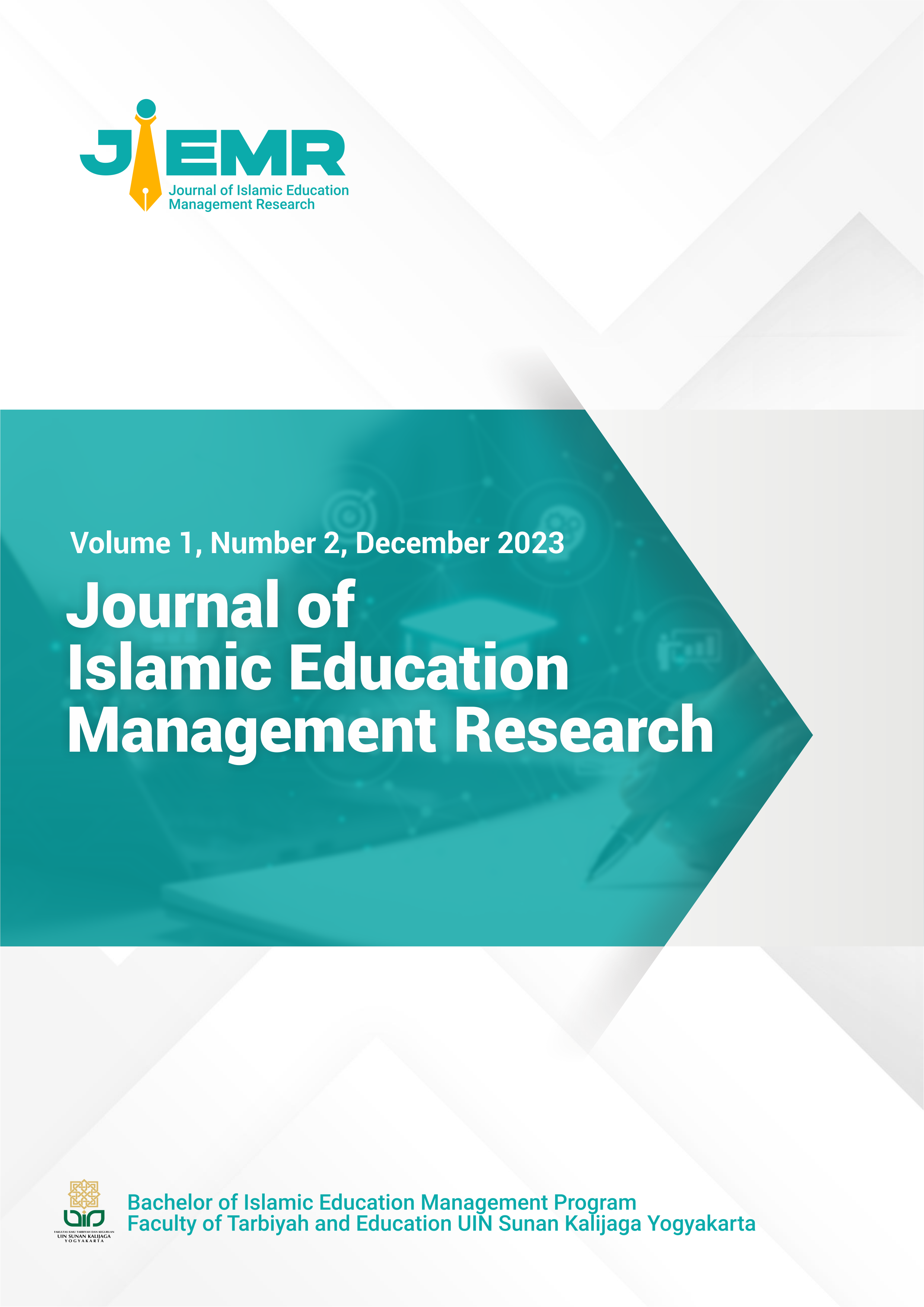Exploring Communication Dynamics in Organizational Leadership and Work Behavior: A Case Study of SEMA FITK UIN Sunan Kalijaga
DOI:
https://doi.org/10.14421/jiemr.2023.12-08Keywords:
Keywords: Leadership, Organizational Communication, Work BehaviorAbstract
Purpose – This study aims to delve into the intricate relationship between communication, leadership, and work behavior within the Faculty of Tarbiyah and Teacher Training (FITK) at UIN Sunan Kalijaga, focusing on the Student Executive Board (SEMA).
Design/methods/approach – Employing a qualitative descriptive research design, the study utilized primary data from interviews with key SEMA figures and observational techniques, supplemented by extensive library research for secondary data. This approach facilitated a comprehensive understanding of the communication dynamics within SEMA FITK.
Findings – The research revealed that effective communication is pivotal in guiding, motivating, and enhancing organizational performance and human resource management. Leadership within the organizational culture, communication patterns, and their interconnectedness with work behavior emerged as key factors influencing organizational success.
Research implications/limitations – The findings contribute to existing literature on organizational communication, leadership, and work behavior. However, the study is limited by its specific focus and reliance on secondary data. Future research should include diverse organizational types and investigate digital communication tools.
Practical implications – The study highlights the importance of integrating effective communication strategies in organizational management and human resource practices to foster a positive culture and enhance performance.
Originality/value – This research underscores the critical role of communication in organizational contexts, illustrating its complex interplay with leadership and work behavior. It provides valuable insights for both theoretical and practical applications in organizational management.
Downloads
References
Creswell, J. W. (2014). Research design: Qualitative, quantitative, and mixed methods approaches (4th ed.). Sage, Los Angeles.
Effendy, O. U. (2009). Ilmu Komunikasi Teori dan Praktek. PT Remaja Rosdakarya, Bandung.
Galushkin, A. A. (2018). The use of information and communications technology to foster the competitiveness of the entrepreneurial organizations within the education and science sector. International Journal of Engineering and Technology, 7(14).
Hubeis, M. & et al. (2012). Komunikasi Profesional: Perangkat Pengembangan Diri. PT Penerbit IPB Press, Bogor.
Januar. (2021). Strategi Komunikasi Kepemimpinan pada Era Digital. Jurnal Ilmiah Pascasarjana, 2, 126–142.
Mulyadi dan Rivai. (2009). Manajemen Sumber Daya Manusia. Penerbit di Jakarta, Jakarta.
Muslih, B. (2020). Urgensi Komunikasi dalam Menumbuhkan Motivasi di Era Pandemi Covid-19. Jurnal Penelitian Manajemen Terapan (Penataran), 5(1), 57–65.
Pace, R. W., & Faules, D. F. (1993). Komunikasi organisasi: Strategi meningkatkan kinerja perusahaan. Remaja Rosdakarya, Bandung.
Perkasa, T. A., & Rafinita, A. (2023). Strategi Komunikasi Kepemimpinan: Suatu Tinjauan Teoritis. Journal of Student Research, 1(2), 367–377.
Puspitasari, D. & Bayu.P.D. (2022). Pentingnya Peranan Komunikasi dalam Organisasi: Lisan, Non Lisan, Verbal, dan Tertulis (Literature Review Manajemen). JEMSI: Jurnal Ekonomi Manajemen Sistem Informasi, 3(2), 257–268.
Rahmawati, Y. (2016). Manajemen Public Relations Sebagai Alat Etika Komunikasi dalam Bisnis Islam. JURNAL SALAM FILSAFAT DAN BUDAYA HUKUM, 1(2), 181–194.
Rojas de la Puente, E. E., & Ayay, A. G. (2021). Tidak ada judul artikel yang disediakan. Revista de Ciencias Sociales. https://produccioncientificaluz.org/index.php/rcs/article/view/36487/39189
Ruliana, P. (2016). Komunikasi Organisasi. Teori dan Studi Kasus. Penerbit Rajawali Pers, Jakarta.
Salvador, P., Rodrigues, C., Lima, K., Alves, K., & Santos, V. (2015). Use and development of teaching technologies presented in nursing research. Rev Rene, 16(3), 442–450. https://doi.org/10.15253/2175-6783.2015000300018
Siagian, S. P. (2002). Kiat Meningkatkan Produktivitas Kerja (Cetakan Pertama). PT. Rineka Cipta,Jakarta.
Siregar. F.A, & Lailatul, U. (2021). Peran Komunikasi Organisasi dalam Menajemen Konflik. Jurnal Idarah: Pendidikan Dan Kependidikan, 5(2), 163–174.
Suranta, S. (2002). Dampak motivasi Karyawan pada Hubungan antara Gaya Kepemimpinan dengan Kinerja Karyawan Perusahaan Bisnis. Jurnal Empirika, 15(2), 116–138.
Suranta, S., Gustomo, & Silvianita. (2009). Dampak motivasi Karyawan pada Hubungan antara Gaya Kepemimpinan dengan Kinerja Karyawan Perusahaan Bisnis. Jurnal Kelompok Keahlian Manajemen Manusia Dan Kewirausahaan Sekolah Bisnis Dan Manajemen Institut Teknologi Bandung, 15(2), 116–138.
Van Riel, C. B. M., & Fombrun, C. J. (2007). Essentials of Corporate Communication: Implementing Practices for Effective Reputation Management. Routledge, United Kingdom.
Zahara, E. (2018). Peranan Komunikasi Organisasi bagi Pimpinan Organisasi. Jurnal Warta, Edisi 56, 1.
Zamzami, & Wili, S. (2021). Strategi Komunikasi Organisasi. Cybernetics: Journal Educational Research and Social Studies, 2(1), 25–37.
Downloads
Published
Issue
Section
License
Copyright (c) 2023 Diah Khoirohnisah, Khayyun Latifah, Rina Khaerunnisa, Syaras Luthfiasari

This work is licensed under a Creative Commons Attribution-NonCommercial-ShareAlike 4.0 International License.
Copyright Notice
Authors who publish with this journal agree to the following terms:
- Authors retain copyright and grant the journal right of first publication with the work simultaneously licensed under a Creative Commons Attribution-ShareAlike 4.0 International License that allows others to copy and redistribute the material in any medium or format with an acknowledgement of the work's authorship and initial publication in this journal and also allows to remix, transform, and build upon the material for any purpose, even commercially with contributions under the same license as the original.
- Authors are able to enter into separate, additional contractual arrangements for the non-exclusive distribution of the journal's published version of the work (e.g., post it to an institutional repository or publish it in a book), with an acknowledgement of its initial publication in this journal.
- Authors are permitted and encouraged to post their work online (e.g., in institutional repositories or on their website) prior to and during the submission process, as it can lead to productive exchanges, as well as earlier and greater citation of published work.









